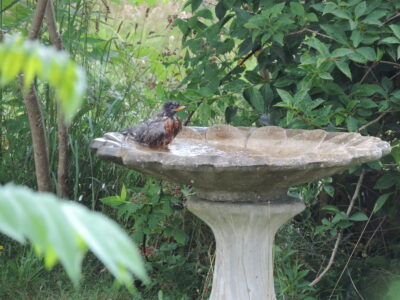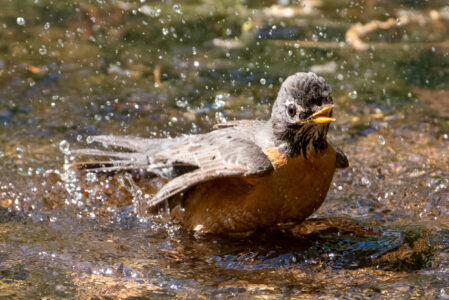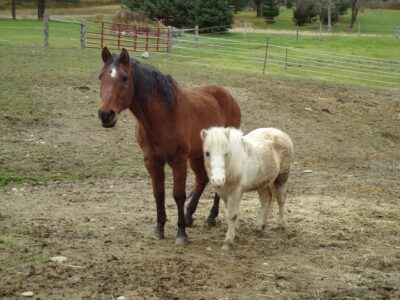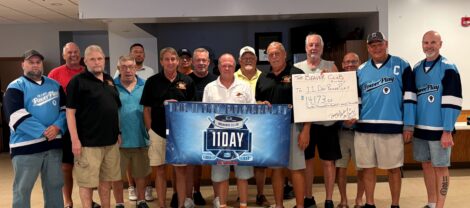Bird baths offer one more invitation

Photo by Katie Finch An American Robin in a backyard bird bath.
- Photo by Katie Finch An American Robin in a backyard bird bath.
- May 23, 2021 – Horn Pond Recreation Area, Woburn, Massachusetts – American Robin taking a bath
Bird baths come in many shapes, sizes, and designs. The one I acquired is a shallow, concrete bowl in the shape of a flower that sits atop a concrete pedestal. I’m so glad it was left behind because watching birds use it is a delightful backyard wildlife viewing experience.
Birds need fresh, clean water for drinking and bathing. They may find water from natural sources such as ponds, creeks, and puddles. Putting out water in a bird bath is another way to provide habitat for birds and attract them to your yard.
The bird bath in my yard sits in line with my bird feeders, just in front of some large forsythia bushes and sumac trees. The plants provide much needed cover for birds as they visit to feed and bathe. Flying in, they land in the bushes or trees first. The vegetation gives them a place to scope out the area and decide when it is safe to come out. Feeding and bathing is a vulnerable time for birds.
Sometimes a single American Goldfinch swoops down, grabs a drink and darts away. Other times, usually when it is hot, it seems like there’s a line. One bird hops out and another one hops in a few seconds later.
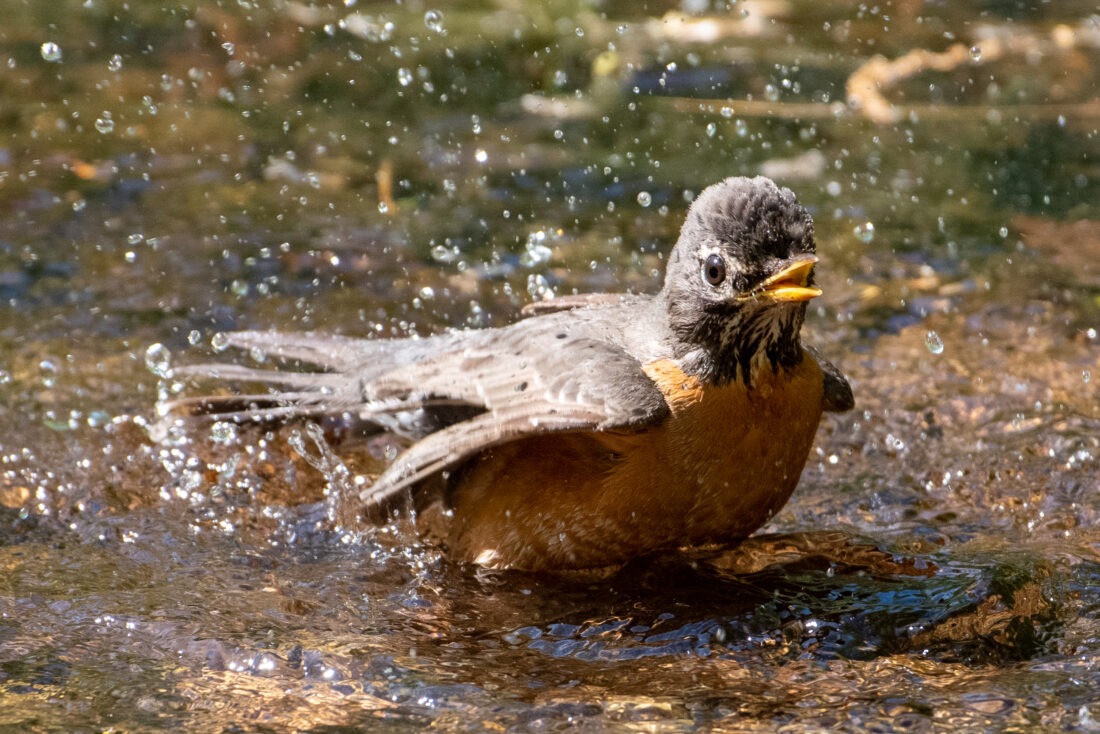
May 23, 2021 - Horn Pond Recreation Area, Woburn, Massachusetts - American Robin taking a bath
On many evenings, just as light changes to that warm glow cast by the setting sun, an American Robin comes in for a bath. Is it the same robin each day? There’s no good way to know. But I like to image it is the female who is also tending to the full nest of babies in the forsythia bush, and this is her only moment to step away and have a quiet bath to herself.
At first, the robin perches on the edge and looks around. Then she goes all in, dipping her head down and quickly back up, letting the water roll down her back. She shakes her whole body, and her feathers fluff up. She repeats this up to a dozen times until she looks worse than when she started. This is a delight to watch and sometimes makes me laugh out loud. It almost looks like she’s enjoying this, despite her drenches and rumpled appearance. But, as she sits on the nearby Shepard’s hook and preens, she also looks refreshed.
Just as feeding songbirds supplements their food source, bird baths supplement their water source. They are also an additional element that allow you to watch birds in your own yard. If you do put up a birdbath, there are some best practices to keep the birds that use it healthy.
Bird baths should be shallow, one to two inches deep at the most. If you have a deeper container, use rocks to fill in the space. Replace the water every day or every other day. Not only will it need to be refilled but also cleaned. Birds are messy, not caring that they are bathing and relieving themselves in the same place.
You can purchase a bird bath but can also use any shallow container, such as a large bottom tray for a flowerpot or a saucer-shaped sled. It can be elevated or placed on the ground.
Bird baths are not swimming pools. You don’t need to close them up at the end of summer, they can be kept year-round. It is a little more work since the water will freeze. You can put out fresh water every day or invest in a heater if you really want. I’m going to try and make it a winter morning ritual to head to the bird bath with a bucket and scrub brush to keep mine at least partially open this winter.
The National Wildlife Federation’s Backyard Wildlife Habitat program encourages individuals or groups to transform lawns or open spaces into healthier habitats for wildlife. They provide education and resources, as well as a certification program.
Any small space such as a home, church, school, or community yard can be a habitat, as long as it contains the required elements. Water is one of the requirements for certification, along with food, cover, places to raise young, and sustainable practices. A bird bath counts as access to water. For more information, visit nwf.org/garden.

